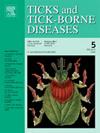IxsS7:一种新的肩胛骨蜱叮咬暴露生物标志物
IF 3.4
2区 医学
Q2 INFECTIOUS DISEASES
引用次数: 0
摘要
肩胛骨硬体是几种重要蜱传病原体的主要媒介,包括感伯氏疏螺旋体、莱姆病的致病细菌基因种复合体、微小巴贝斯虫、嗜吞噬细胞无形体、宫本氏疏螺旋体、穆拉氏埃利希体和波瓦桑病毒。肩胛骨蜱在吸血过程中分泌的唾液化合物具有免疫原性,可在人体中引起强大的抗体反应,这可能被用作以前蜱叮咬暴露的替代标记。在这项研究中,我们研究了蜱分泌唾液丝氨酸蛋白酶抑制剂IxsS7作为人类暴露于肩胛骨恙虫的新型抗原生物标志物的潜力。研究表明,IxsS7蛋白编码序列在其他重要蜱属(如蓖麻蜱、过弯蜱和太平洋蜱)中高度保守(同源性为90%),而与其他蜱属(如Amblyomma spp.、Dermacentor spp.、Rhipicephalus spp.)的同源物保守性较差(同源性为50%)。重组IxsS7 (rIxsS7)免疫家兔的血清抗体在被血喂养的雌性肩胛骨蜱的唾液腺浆液(SGH)攻击时强烈识别原生IxsS7,而与其他硬蜱(伊蚊科)属的SGH表现出最小的交叉反应性。Western blot和ELISA分析显示,报告最近接触过蜱虫的人类受试者具有识别rIxsS7的IgG抗体,突出了其作为特异性暴露于肩胛骨恙虫的生物标志物的潜力。进一步开发血清学工具,以测量人类对伊蚊特异性唾液抗原的抗体反应,这对于更好地量化个体和人群层面的重要蜱传疾病(如莱姆病)风险至关重要。本文章由计算机程序翻译,如有差异,请以英文原文为准。
IxsS7: A novel biomarker for Ixodes scapularis tick bite exposure in humans
Ixodes scapularis is a primary vector of several important tick-borne pathogens including Borrelia burgdorferi sensu lato, the causative bacterial genospecies complex of Lyme disease, Babesia microti, Anaplasma phagocytophilum, Borrelia miyamotoi, Ehrlichia muris eauclarensis, and Powassan virus. Salivary compounds secreted by I. scapularis during blood feeding are immunogenic and can elicit robust antibody responses in humans which can potentially be leveraged as surrogate markers of prior tick bite exposure. In this study, we investigate the potential of a tick secreted salivary serine protease inhibitor, IxsS7, as a novel antigenic biomarker of I. scapularis exposure in humans. We demonstrate that the IxsS7 protein-coding sequence is highly conserved (>90 % identity) among other important Ixodes species (e.g., Ixodes ricinus, Ixodes persulcatus, and Ixodes pacificus) and poorly conserved (<50 % identity) with homologs from other tick genera, such as Amblyomma spp., Dermacentor spp., Rhipicephalus spp., and Haemaphysalis spp. Antibodies in sera from rabbits immunized with recombinant IxsS7 (rIxsS7) strongly recognize native IxsS7 when challenged with salivary gland homogenate (SGH) from blood-fed I. scapularis females, while showing minimal cross-reactivity with SGH from other hard tick (Ixodidae) genera. Western blot and ELISA analyses revealed that human subjects who reported recent prior exposure to ticks possessed IgG antibodies that recognized rIxsS7, highlighting its potential as a biomarker of exposure specifically against I. scapularis. Further development of serological tools that can measure human antibody responses to Ixodes-specific salivary antigens is essential to better quantify individual- and population-level risk of important tick-borne diseases such as Lyme disease.
求助全文
通过发布文献求助,成功后即可免费获取论文全文。
去求助
来源期刊

Ticks and Tick-borne Diseases
INFECTIOUS DISEASES-MICROBIOLOGY
CiteScore
6.90
自引率
12.50%
发文量
185
审稿时长
6-12 weeks
期刊介绍:
Ticks and Tick-borne Diseases is an international, peer-reviewed scientific journal. It publishes original research papers, short communications, state-of-the-art mini-reviews, letters to the editor, clinical-case studies, announcements of pertinent international meetings, and editorials.
The journal covers a broad spectrum and brings together various disciplines, for example, zoology, microbiology, molecular biology, genetics, mathematical modelling, veterinary and human medicine. Multidisciplinary approaches and the use of conventional and novel methods/methodologies (in the field and in the laboratory) are crucial for deeper understanding of the natural processes and human behaviour/activities that result in human or animal diseases and in economic effects of ticks and tick-borne pathogens. Such understanding is essential for management of tick populations and tick-borne diseases in an effective and environmentally acceptable manner.
 求助内容:
求助内容: 应助结果提醒方式:
应助结果提醒方式:


